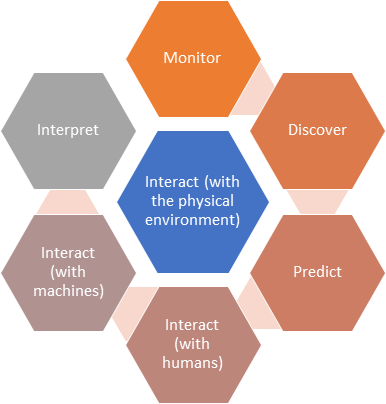Leveraging AI in the public sector with open data
Using AI in the public sector is possible, but how?
Artificial Intelligence (AI) software has been called the most disruptive force in technology and it offers an unprecedented opportunity to transform both the private- and public services sector. It is a priority for the European Union and the European Commission recently presented a series of measure to boost Europe's competitiveness in this field. In the public sector, AI applications are still only used to a small extent though. A key question is: how can the potential of AI applications in the public sector be unleashed? Open Data can play an important role in realising this.
What can AI do for society?
AI techniques can unravel deeper insights from sets of data than traditional statistical techniques. Examples of AI are: speech recognition, natural language processing, chatbots or voice bots. In most cases, AI applications have at least one of the following seven functions: monitoring, discovering, predicting, interpreting, interacting with the physical environment, interacting with humans and interacting with machines.

Figure 1 AI functions
By using AI, organisations can boost their productivity and optimise their services through automating processes, optimising rational decision-making and simplifying complex tasks. While the adoption of AI applications in the public sector is not going as fast as in the private sector, several noteworthy AI practices in the public sector can be named. An AI system of The UK Ministry of Justice for instance can sift, index and summarise documents as a human investigator would do, but much faster and without human error. The AI sorts documents into "privileged" and "non-privileged" piles, a time-consuming legal process that would have otherwise been done by humans over many months. The robot helped the team sift through 30 million documents, processing up to 600,000 documents every day. Nevertheless, the use of AI in the public sector is rather an exception than a common practice.
Three phases of AI
In general, AI can be distinguished into three generations or phases. In phase 1, AI is able to automate processes that are routine and do not change over time. In phase 2 AI is able to adapt to- and learn from changes in the automated process. In phase 3, AI proactively provides new and innovative insights by being able to analyse and learn from its previous actions.
Currently, this third phase of AI is the most advanced technology in the private sector, but the expectation is that more complex AI levels with larger potential value will be created in the future. In the public sector on the other hand, some government departments have adopted AI mainly for its ability to automate processes without making use of its predictive analytic capabilities as seen in the private sector. The most advanced AI level in the public sector at the moment is in phase 2.
Bringing AI and Open Data together
It is up to governments to take the best possible advantage of the AI revolution. But what is needed for this? Three key ingredients are crucial:
- (Open) Data
Obviously, AI systems need data to function. To function properly 1) data volume, 2) data variety and 3) data veracity are crucial for getting AI systems to work. This is especially important to avoid biases and possible discrimination as machines start learning by themselves on the basis of the data that has been provided. In addition, Open Data is needed to assist public organisations in fostering innovation. Open Data is data that is made available by mostly public organisations but also by businesses and individuals for anyone to access, use and share. Access to open data will unlock the potential of data-hungry AI applications for organisations in both the public sector and the private sector.
However, there are several barriers that still hinder the re-use of open data. The barriers faced can be clustered into six categories:
- Political barriers;
- Organisational barriers;
- Legal barriers;
- Technical barriers;
- Financial barriers;
- (lack of) Awareness.
Next to open data, two other factors are crucial to fuel the AI revolution in the public sector:
- An innovative mindset
Making progress on AI means that the mindset of 'business as usual' needs to change. For organisations in the public sector it is therefore important to foster a culture that embraces innovation, brings out creativity and eliminates barriers to innovation.
- Necessary skills
It is vital to have the necessary skills in the workforce to be able to identify where AI should and should not be used, and to help build effective tools and systems. Increasing investment in a competent workforce will help in upgrading the skills and knowledge on AI use in the public sector.
What will the future bring?
The combination of AI and Open Data is a winning one. However, efforts have to be taken to realise the benefits of AI in governmental organisations. An important step in the right direction is for governments to make their data available for re-use. By doing this, this data can be used for innovative purposes such as AI. Only then can governments prepare themselves for the future and move to a new level of AI. Next to this, the ambition of the European Commission with a comprehensive European approach to artificial intelligence and robotics shows that AI is seen as an important priority that Europe is responding to.
It is expected that the possibilities of AI will further expand in the future as the amount of data increases, for example because of more real-time sensors that are increasingly being installed in cities and on highways. Sensors can function as an additional source for AI applications and some cities already have a policy on opening up the data of sensors in public spaces. Large-scale use of AI can have a significant impact in many domains, for example in the healthcare sector, the educational sector, transportation, public order and safety. Open data can help realise this potential.
